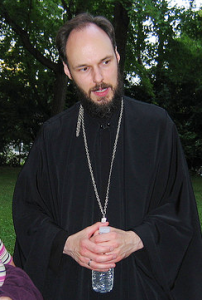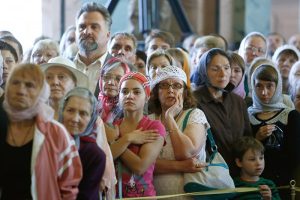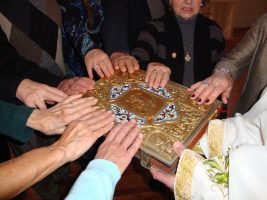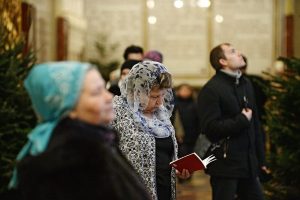Editor’s note: We continue to publish reflections on the topic of church attendace in the west.
Why is Attendance Declining in Russian Churches in the West?
“The Heart of the Parish Community Must be Love”

Fr. Geoffrey Korz
While America is generally seen as a melting pot, where religion has a prominent place in the public square, Canada is very much a cultural mosaic, where religion is often viewed as a private matter, and where the public square is silent on religious questions, if not actually antireligious. These differences, coupled with the constant stream of immigrants to Canada from a variety of countries with Orthodox heritage, has shaped the growth and attendance at Orthodox parishes in Canada.
Over the last two decades, growth in the number of parishes has been measurable. Parishes of the Orthodox Church in America have doubled in number (along with a doubling of clergy). Antiochian missions have seen growth in new neighbourhoods, as well as Arab communities. In the cases of parishes made up of adult converts to the Orthodox Faith, these parishes are in almost all cases small parishes, under fifty parishioners, with priests who are paid little or nothing at all, and who hold other secular employment.
Other Orthodox jurisdictions (there are more than ten, since North America experienced a jurisdictional division in the 1920s) have seen fluctuation based on immigration patterns. Russian language missions (of the OCA, the Moscow Patriarchate, and the Russian Orthodox Church Outside Russia) have been growing in major cities such as Toronto, Montreal, Calgary, and Vancouver. The growth in these communities cannot be attributed to pious Russians immigrants alone, but also to converts from Judaism, Islam, and non-religious backgrounds, including atheism. Immigration from former Soviet republics has contributed the majority of these faithful.
Among the Greek-speaking parishes, Greek immigration reached plateau in the 1960s. In Canada today, some suggest a reverse immigration is underway, as Greeks in their retirement years return to the land of their birth to take up residence in family-owned homes. Like many Orthodox jurisdictions in Canada, there is a struggle between those who want to retain younger generations through nationalism (a demonstrated failing strategy for the Church), and those who cultivate spiritual life through connection to attendance at holy services and at monasteries. There exists a growing phenomenon of Greeks – as well as converts in Greek parishes – effectively considering as their home parishes the many Greek-language monasteries in Canada and the states along the Canada-U.S. border, a practice virtually unknown in Canada a decade ago. The spiritual and demographic implications of this trend for the Greek parishes is gradually being felt, although the spiritual awakening of many Greek community councils has yet to be fully manifested.
Ukrainian Orthodox Canadians – the pioneers of Orthodox Christianity in Canada’s vast rural provinces, and a century ago the dominant Orthodox community – are an aging group, yet attendance and support of parish life remain strong in many areas. While the transfer of the faith to new generations remains in doubt, the clergy seem acutely aware of this reality, and something of a quiet spiritual resuscitation through increased holy services, spiritual education, and spiritual life have brought new life to a significant minority within the Ukrainian Orthodox jurisdiction. While attendance patterns among the Ukrainian Orthodox faithful in Canada remain consistent, the absence of youth and the fading of the use of the Ukrainian language in daily life (Ukrainian was noted as the fastest shrinking language of use in the country in the last census) have an impact which must still be faced.
Among the Serbs in Canada, immigration in 1990s as a result of the conflicts in the Balkans has increased membership and attendance in most Serbian parishes, and has seen a handful of new parishes begin in major residential areas in the last decade. Strong political ties to the Serbian homeland have helped to cement the Serbian community; they face one of the lowest rates of exogamy (marrying out of the culture and/or faith) of any Orthodox group in Canada. The vestiges of decades of Communism have taken their toll on the faith and practice of the people, however, and there is much catechism to be done among adults as well as young people in Serbian parishes. A number of spiritually vibrant parishes in eastern Canada have taken up this challenge: the recent translation of a copy of the Icon of Three Hands from the Hilandar Monastery on Mount Athos to Hamilton, Ontario, along with the translation of relics of St. John (Maximovitch) of San Francisco to Kitchener, Ontario, have proven to be spiritual magnets for the faithful from various jurisdictions, and have seen very concrete spiritual growth among these Orthodox communities.
While attendance and parish numbers across Orthodox jurisdictions in Canada are up, connections between faith and attitudes in daily life remain an open question. Many Orthodox Christians who are new to Canada remain afflicted by a very strong Canadian imperative to assimilate to materialistic, relativistic values. For this reason, the vast majority of Orthodox in Canada are reluctant to challenge shifts toward immoral teaching and attitudes in public education and the media. Attitudes towards sexual promiscuity, as well as rates of abortion, are no different among Orthodox young people than they are among the general Canadian population. With a well-funded social welfare state providing generously for healthcare and social service needs, most Orthodox parishes tend to focus on supporting various causes abroad, and pay little attention to charitable or mission work in their own neighbourhoods.
There are many exceptions to this, of course. Generous charitable endeavours take place among the faithful of every Orthodox jurisdiction in Canada. Most support mission work in some way. The prosperity that Canada enjoys provides a great temptation to Orthodox Christians, however, a temptation that very often sees Orthodox Christians skip Sunday Liturgy to tend to family businesses, and encourage academic and economic success among their children ahead of spiritual and eternal success.
The faithful in most countries would be envious of the many blessing, both spiritual and material, enjoyed by the Orthodox Church in Canada. For Orthodox Christians here, however, a strong, countercultural turn must be taken toward a deeper spiritual life and a rejection of materialism, which will only then bear fruit in missionary witness and works of love and charity. Only then will the Church in our land be able to achieve the longed-for goal, that Orthodox Christians in Canada will be recognized as such because of their inner stillness and peace, and through that, because of their love.
Father Geoffrey Korz is Dean of Ontario, Canada’s largest province, and Rector of the parish of All Saints of North America (OCA) in Hamilton.



















